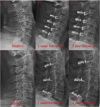All-Level Versus Alternative-Level in Unilateral Laminoplasty: A Retrospective Comparative Study
- PMID: 40485046
- PMCID: PMC12214410
- DOI: 10.1111/os.70100
All-Level Versus Alternative-Level in Unilateral Laminoplasty: A Retrospective Comparative Study
Abstract
Objective: Titanium mini-plates are applied in unilateral open-door laminoplasty to secure the elevated laminae and prevent re-closure. Whereas the conventional technique fixates every level, some surgeons plate only alternate levels to curb implant costs. Whether they could achieve similar long-term clinical and radiographic efficacy is still questionable. This study aimed to compare the efficacy and safety of alternative-level fixation versus all-level fixation in cervical laminoplasty for multilevel cervical spondylotic myelopathy (CSM).
Methods: A retrospective analysis is conducted on 65 patients who underwent C3-C7 unilateral laminoplasty at Peking University People's Hospital from July 2012 to December 2020. Patients are divided into two groups: alternative-level fixation and all-level fixation. Clinical outcomes, including operative time, intraoperative blood loss, postoperative hospitalization days, and complications, are assessed. The Japanese Orthopaedic Association (JOA) score is used for neurological function evaluation, while pain is assessed with the Visual Analog Scale (VAS). Radiographic outcomes include changes in anterior-posterior diameter, Pavlov ratio, cervical lordosis (CL), thoracic slope (T1S), and sagittal vertical axis (SVA).
Results: Both groups showed significant improvements in JOA (15.94 ± 0.85 vs. 8.74 ± 1.76 in alternative-level and 16.1 ± 0.79 vs. 8.42 ± 1.84 in all-level) and VAS (1.03 ± 0.87 vs. 5.79 ± 1.18 in alternative-level, 1.06 ± 0.77 vs. 5.35 ± 1.17 in all-level) postoperatively, with no statistically significant differences in clinical outcomes between the groups (JOA: 15.94 ± 0.85 vs. 16.1 ± 0.79, p = 0.394; VAS: 1.03 ± 0.87 vs. 1.06 ± 0.77, p = 0.432). Although total hospital costs are significantly lower in the alternative-level fixation group (124,937 ± 5104.01 RMB vs. 88007.53 ± 7014.53, p < 0.001), the all-level fixation group demonstrated better long-term preservation of APD (17.87 ± 0.60 vs. 17.50 ± 0.52) at the final follow-up. Radiographic outcomes, including CL, T1s, and cSVA, show no significant differences between the two groups, indicating comparable spinal alignment outcomes.
Conclusion: Both all-level and alternative-level fixation methods effectively support the lamina and prevent reclosure, with significant improvement in clinical symptoms in both groups at the final follow-up, showing no significant difference in postoperative clinical outcomes between the two. There are no differences in sagittal parameters. All-level fixation method showed better preservation of the spinal canal diameter.
Keywords: all‐level; alternative‐level; anterior–posterior diameter; cervical spondylotic myelopathy; laminoplasty.
© 2025 The Author(s). Orthopaedic Surgery published by Tianjin Hospital and John Wiley & Sons Australia, Ltd.
Conflict of interest statement
The authors declare no conflicts of interest.
Figures




Similar articles
-
Clinical efficacy of modified laminoplasty in the treatment of cervical spondylotic myelopathy.BMC Musculoskelet Disord. 2025 Aug 23;26(1):816. doi: 10.1186/s12891-025-08989-y. BMC Musculoskelet Disord. 2025. PMID: 40849646 Free PMC article.
-
Comparative clinical outcomes of ACDF with self-locking cage, cage combined with plate, and posterior laminoplasty in long-level cervical spondylosis: a two-year follow-up study.BMC Surg. 2025 Aug 4;25(1):338. doi: 10.1186/s12893-025-02993-8. BMC Surg. 2025. PMID: 40760656 Free PMC article.
-
[Imaging changes of the intervertebral disc after posterior cervical single door enlarged laminoplasty for cervical spinal stenosis with disc herniation].Zhongguo Gu Shang. 2025 Jun 25;38(6):572-80. doi: 10.12200/j.issn.1003-0034.20230109. Zhongguo Gu Shang. 2025. PMID: 40603117 Chinese.
-
Comparison of anterior approach versus posterior approach for the treatment of multilevel cervical spondylotic myelopathy.Eur Spine J. 2015 Aug;24(8):1621-30. doi: 10.1007/s00586-015-3911-4. Epub 2015 Apr 4. Eur Spine J. 2015. PMID: 25840781
-
A systematic review of clinical and surgical predictors of complications following surgery for degenerative cervical myelopathy.J Neurosurg Spine. 2016 Jan;24(1):77-99. doi: 10.3171/2015.3.SPINE14971. Epub 2015 Sep 25. J Neurosurg Spine. 2016. PMID: 26407090
References
-
- Hirabayashi K., Watanabe K., Wakano K., et al., “Expansive Open‐Door Laminoplasty for Cervical Spinal Stenotic Myelopathy,” Spine (Phila Pa 1976) 8 (1983): 693–699. - PubMed
-
- Deutsch H., Mummaneni P. V., Rodts G. E., and Haid R. W., “Posterior Cervical Laminoplasty Using a New Plating System: Technical Note,” Journal of Spinal Disorders & Techniques 17 (2004): 317–320. - PubMed
-
- Park A. E. and Heller J. G., “Cervical Laminoplasty: Use of a Novel Titanium Plate to Maintain Canal Expansion—Surgical Technique,” Journal of Spinal Disorders & Techniques 17 (2004): 265–271. - PubMed
-
- Cheung J. P. Y., Cheung P. W. H., Cheung A. Y. L., Lui D., and Cheung K. M. C., “Comparable Clinical and Radiological Outcomes Between Skipped‐Level and All‐Level Plating for Open‐Door Laminoplasty,” European Spine Journal 27 (2018): 1365–1374. - PubMed
Publication types
MeSH terms
Grants and funding
LinkOut - more resources
Full Text Sources
Medical
Miscellaneous

